Related Research Articles
The Carboniferous is a geologic period and system of the Paleozoic that spans 60 million years from the end of the Devonian Period 358.9 million years ago (Mya), to the beginning of the Permian Period, 298.9 million years ago. The name Carboniferous means "coal-bearing", from the Latin carbō ("coal") and ferō, and refers to the many coal beds formed globally during that time.
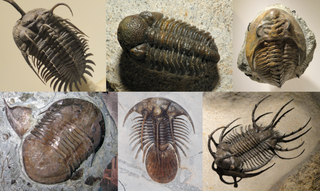
Trilobites are extinct marine arthropods that form the class Trilobita. Trilobites form one of the earliest known groups of arthropods. The first appearance of trilobites in the fossil record defines the base of the Atdabanian stage of the Early Cambrian period and they flourished throughout the lower Paleozoic before slipping into a long decline, when, during the Devonian, all trilobite orders except the Proetida died out. The last extant trilobites finally disappeared in the mass extinction at the end of the Permian about 252 million years ago. Trilobites were among the most successful of all early animals, existing in oceans for almost 270 million years, with over 22,000 species having been described.
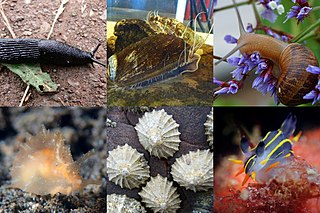
The gastropods, commonly known as slugs and snails, belong to a large taxonomic class of invertebrates within the phylum Mollusca called Gastropoda.
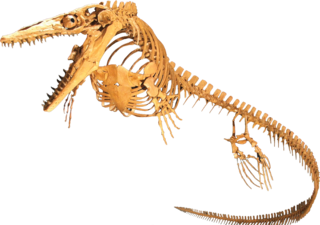
Mosasaurs comprise a group of extinct, large marine reptiles from the Late Cretaceous. Their first fossil remains were discovered in a limestone quarry at Maastricht on the Meuse in 1764. They belong to the order Squamata, which includes lizards and snakes.

Goniatids, informally goniatites, are ammonoid cephalopods that form the order Goniatitida, derived from the more primitive Agoniatitida during the Middle Devonian some 390 million years ago. Goniatites (goniatitids) survived the Late Devonian extinction to flourish during the Carboniferous and Permian only to become extinct at the end of the Permian some 139 million years later.

A microfossil is a fossil that is generally between 0.001 mm and 1 mm in size, the visual study of which requires the use of light or electron microscopy. A fossil which can be studied with the naked eye or low-powered magnification, such as a hand lens, is referred to as a macrofossil.
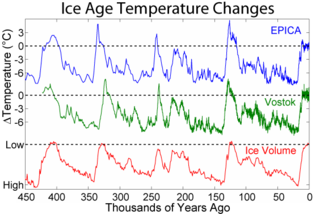
An interglacial period is a geological interval of warmer global average temperature lasting thousands of years that separates consecutive glacial periods within an ice age. The current Holocene interglacial began at the end of the Pleistocene, about 11,700 years ago.
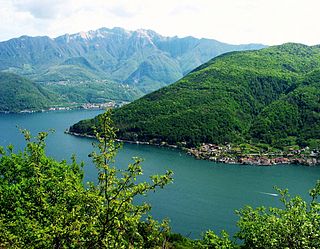
Monte San Giorgio is a mountain and UNESCO World Heritage Site on the border between Switzerland and Italy. It is part of the Lugano Prealps, overlooking Lake Lugano in the Swiss Canton of Ticino.
Poliellina is an extinct genus from a well-known class of fossil marine arthropods, the trilobites. It lived during the early part of the Botomian stage, which lasted from approximately 524 to 518.5 million years ago. This faunal stage was part of the Cambrian Period.
Kuanyangia is an extinct genus from a well-known class of fossil marine arthropods, the trilobites. It lived during the early part of the Botomian stage, which lasted from approximately 524 to 518.5 million years ago. This faunal stage was part of the Cambrian Period.
Labradoria is an extinct genus from a well-known class of fossil marine arthropods, the trilobites. It lived during the early part of the Botomian stage, which lasted from approximately 524 to 518.5 million years ago. This faunal stage was part of the Cambrian Period.
Arthricocephalus is an extinct genus from a well-known class of fossil marine arthropods, the trilobites. It lived during the later part of the Botomian stage, which lasted from approximately 524 to 518.5 million years ago. This faunal stage was part of the Cambrian Period.
Megapalaeolenus is an extinct genus from a well-known class of fossil marine arthropods, the trilobites. They lived during the later part of the Botomian stage, which lasted from approximately 524 to 518.5 million years ago. This faunal stage was part of the Cambrian Period.
Megalaspidella is an extinct genus from a well-known class of fossil marine arthropods, the trilobites. It lived during the later part of the Arenig stage of the Ordovician Period, approximately 478 to 471 million years ago.

Megalaspides is an extinct genus from a well-known class of fossil marine arthropods, the trilobites. It lived during the later part of the Arenig stage of the Ordovician Period, approximately 478 to 471 million years ago.

In geology, the Arenig is a time interval during the Ordovician period and also the suite of rocks which were deposited during this interval.

The Bontnewydd palaeolithic site, also known in its unmutated form as Pontnewydd, is an archaeological site near St Asaph, Denbighshire, Wales. It is one of only three sites in Britain to have produced fossils of ancient species of humans and the only one with fossils of a classic Neanderthal. It is located a few yards east of the River Elwy, near the hamlet of Bontnewydd, near Cefn Meiriadog, Denbighshire.
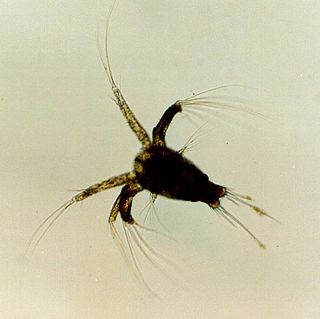
Crustaceans may pass through a number of larval and immature stages between hatching from their eggs and reaching their adult form. Each of the stages is separated by a moult, in which the hard exoskeleton is shed to allow the animal to grow. The larvae of crustaceans often bear little resemblance to the adult, and there are still cases where it is not known what larvae will grow into what adults. This is especially true of crustaceans which live as benthic adults, more-so than where the larvae are planktonic, and thereby easily caught.

Crustaceans belong to the subphylum Crustacea,, and form a large, diverse group of arthropods including decapods, seed shrimp, branchiopods, fish lice, krill, remipedes, isopods, barnacles, copepods, amphipods and mantis shrimp. The crustacean group can be treated as a subphylum under the clade Mandibulata. It is now well accepted that the hexapods emerged deep in the Crustacean group, with the completed group referred to as Pancrustacea. Some crustaceans are more closely related to insects and the other hexapods than they are to certain other crustaceans.

Yamatosaurus is a genus of basal hadrosaurid from the Late Cretaceous (Maastrichtian)-aged Kita-Ama Formation of Awaji Island, Japan. The genus contains a single species, Yamatosaurus izanagii.
References
- 1 2 Sepkoski, Jack (2002). "A compendium of fossil marine animal genera (Trilobita entry)". Bulletins of American Paleontology. 364: 560. Archived from the original on September 5, 2006. Retrieved 2008-01-12.